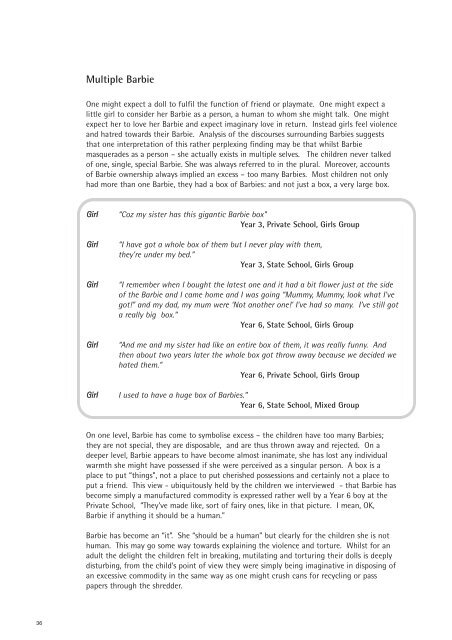The Simpsons are Cool but Barbie's a Minger - Professor Agnes Nairn
The Simpsons are Cool but Barbie's a Minger - Professor Agnes Nairn
The Simpsons are Cool but Barbie's a Minger - Professor Agnes Nairn
Create successful ePaper yourself
Turn your PDF publications into a flip-book with our unique Google optimized e-Paper software.
36<br />
Multiple Barbie<br />
One might expect a doll to fulfil the function of friend or playmate. One might expect a<br />
little girl to consider her Barbie as a person, a human to whom she might talk. One might<br />
expect her to love her Barbie and expect imaginary love in return. Instead girls feel violence<br />
and hatred towards their Barbie. Analysis of the discourses surrounding Barbies suggests<br />
that one interpretation of this rather perplexing finding may be that whilst Barbie<br />
masquerades as a person – she actually exists in multiple selves. <strong>The</strong> children never talked<br />
of one, single, special Barbie. She was always referred to in the plural. Moreover, accounts<br />
of Barbie ownership always implied an excess – too many Barbies. Most children not only<br />
had more than one Barbie, they had a box of Barbies: and not just a box, a very large box.<br />
Girl “Coz my sister has this gigantic Barbie box”<br />
Year 3, Private School, Girls Group<br />
Girl “I have got a whole box of them <strong>but</strong> I never play with them,<br />
they’re under my bed.”<br />
Year 3, State School, Girls Group<br />
Girl “I remember when I bought the latest one and it had a bit flower just at the side<br />
of the Barbie and I came home and I was going “Mummy, Mummy, look what I’ve<br />
got!” and my dad, my mum were ‘Not another one!’ I’ve had so many. I’ve still got<br />
a really big box.”<br />
Year 6, State School, Girls Group<br />
Girl “And me and my sister had like an entire box of them, it was really funny. And<br />
then about two years later the whole box got throw away because we decided we<br />
hated them.”<br />
Year 6, Private School, Girls Group<br />
Girl I used to have a huge box of Barbies.”<br />
Year 6, State School, Mixed Group<br />
On one level, Barbie has come to symbolise excess – the children have too many Barbies;<br />
they <strong>are</strong> not special, they <strong>are</strong> disposable, and <strong>are</strong> thus thrown away and rejected. On a<br />
deeper level, Barbie appears to have become almost inanimate, she has lost any individual<br />
warmth she might have possessed if she were perceived as a singular person. A box is a<br />
place to put “things”, not a place to put cherished possessions and certainly not a place to<br />
put a friend. This view - ubiquitously held by the children we interviewed - that Barbie has<br />
become simply a manufactured commodity is expressed rather well by a Year 6 boy at the<br />
Private School, “<strong>The</strong>y’ve made like, sort of fairy ones, like in that picture. I mean, OK,<br />
Barbie if anything it should be a human.”<br />
Barbie has become an “it”. She “should be a human” <strong>but</strong> clearly for the children she is not<br />
human. This may go some way towards explaining the violence and torture. Whilst for an<br />
adult the delight the children felt in breaking, mutilating and torturing their dolls is deeply<br />
disturbing, from the child’s point of view they were simply being imaginative in disposing of<br />
an excessive commodity in the same way as one might crush cans for recycling or pass<br />
papers through the shredder.


